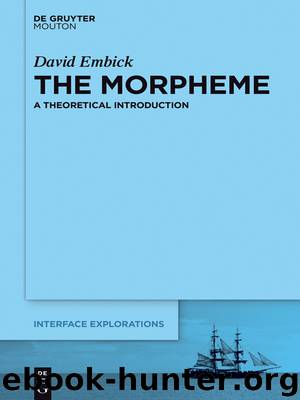The Morpheme by David Embick

Author:David Embick
Language: eng
Format: epub
Publisher: De Gruyter
Published: 2015-03-15T00:00:00+00:00
By (8), the first and second plural subject agreement morphemes (7a) and (7b) are realized via distinct Vocabulary Items, (8a) and (8b) respectively. However, realization of the [+obj] plurals is effected by a single Vocabulary Item, (8c). The fact that this Vocabulary Item must apply with the [+obj] morphemes follows from principles introduced in chapter 4. According to the theory of Vocabulary Insertion developed there, neither (8a,b) can apply to [+obj] morphemes, because they make reference to the feature [+subj]. Since neither of these Vocabulary Items in (8) can apply to (7c) or (7d), the most specific Vocabulary Item that can apply to each of these morphemes is (8c), which inserts noh-. Thus, the two distinct functional morphemes (7c,d) are realized with the same Vocabulary Item (8c); this is what it means to have a systematic syncretism in this theory.
An important component of the analysis based on (8) is that the Vocabulary Item (8c) does not refer to the features [±1] or [±2]. Rather, it refers only to the features [+pl] and [+obj]. Because it does not refer to person features, it is able to apply to both [+1,-2] object plurals and to [-1,+2] object plurals. In the type of situation just described, a Vocabulary Item is said to be underspecified with respect to the feature bundles to which it applies.
The general idea behind this kind of underspecification is that Vocabulary Items are able to apply to functional morphemes that contain a superset of the features that are mentioned in the Vocabulary Item (see section 5.3 below). In the particular case at hand, the effect of underspecifying the Vocabulary Item with the noh- exponent is that it is able to apply to both (7c) and (7d).
Underspecifying Vocabulary Items allows for syncretisms to be analyzed as systematic effects, and not as instances of accidental homophony. The identity in form in the first and second plural object agreement morphemes is systematic, since these two morphemes receive their phonological form from the single Vocabulary Item (8c). Put slightly differently, there is a single morphological object at the center of this analysis, one that allows the exponent noh- to appear in more than one plural morpheme.
Download
This site does not store any files on its server. We only index and link to content provided by other sites. Please contact the content providers to delete copyright contents if any and email us, we'll remove relevant links or contents immediately.
Cecilia; Or, Memoirs of an Heiress — Volume 1 by Fanny Burney(32434)
Cecilia; Or, Memoirs of an Heiress — Volume 2 by Fanny Burney(31871)
Cecilia; Or, Memoirs of an Heiress — Volume 3 by Fanny Burney(31852)
The Lost Art of Listening by Michael P. Nichols(7406)
Asking the Right Questions: A Guide to Critical Thinking by M. Neil Browne & Stuart M. Keeley(5632)
We Need to Talk by Celeste Headlee(5542)
On Writing A Memoir of the Craft by Stephen King(4863)
Dialogue by Robert McKee(4321)
Pre-Suasion: A Revolutionary Way to Influence and Persuade by Robert Cialdini(4145)
I Have Something to Say: Mastering the Art of Public Speaking in an Age of Disconnection by John Bowe(3840)
Elements of Style 2017 by Richard De A'Morelli(3307)
The Book of Human Emotions by Tiffany Watt Smith(3238)
Fluent Forever: How to Learn Any Language Fast and Never Forget It by Gabriel Wyner(3028)
Name Book, The: Over 10,000 Names--Their Meanings, Origins, and Spiritual Significance by Astoria Dorothy(2939)
Good Humor, Bad Taste: A Sociology of the Joke by Kuipers Giselinde(2903)
Why I Write by George Orwell(2874)
The Art Of Deception by Kevin Mitnick(2736)
The Grammaring Guide to English Grammar with Exercises by Péter Simon(2706)
Ancient Worlds by Michael Scott(2623)
